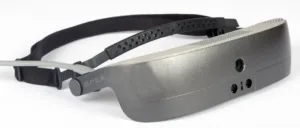Spex, a new division of eSight Corporation (Toronto, Canada) has developed the so-called Super Vision HMD (and showed it at AWE Spex Concentrates on Improving Vision – subscription required). The company describes the Super Vision HMD as “a comfortable, wearable and hands-free device that allows people to use both hands for their tasks all day long.”

The product is aimed at users working in the medical and technical fields and applications. The connecting theme of these disciplines is the need for precision vision without overwriting or obstructing the user’s natural vision. Claimed to be versatile, the Spex is represented as having the potential to replace other devices such as tablets, laptops, desktops, scanners, cameras and paper manuals.
It can be noted that company literature does not especially feature augmented reality applications. Rather, it is the HMD’s ability “to display video and allow the user to zoom in on objects in the real world, as well as view real time data streamed to the device.”
“Spex enhances your vision for precision tasks, allows the user to pan and zoom the real world or streamed images, and brings critical information to the point of task without overwriting or obstructing your natural vision for full situational awareness and mobility.”
Key specifications and features of the Spex Super Vision HMD include the following:
|
Field of view |
37.5º |
|
Camera resolution |
21.7M pixels |
|
Zoom |
24x |
|
OLED display resolution |
1024 x 768 |
|
Latency (camera to display) |
70 ms |
|
Inputs |
HDMI, WiFi |
|
Sound |
Enabled with two way voice and video communication system |
|
Control module |
Tethered |
|
Operating system |
Android running Snapdragon processors |
|
Weight |
100 grams |
The Spex HD camera, in conjunction with associated a high quality lens and a fast auto focus, produces so-called “Super Vision.” The camera provides an acuity of 0.6 arc minutes – which is better than that of the human eye.
The Spex HD let users use the technology while seated and plugged in to HDMI and other video sources but also be fully mobile. More than that, the Spex HMD is claimed to enable mobility without interfering with native and peripheral vision. More specifically, by allowing for hands free use of the HMD and presentation of the best view of video or data while “maintaining use and full access to the user’s native central and peripheral vision while providing an AR view of the world.” This capability is due to the patented Spex Bioptic Tilt Design. The mechanical adjustment of the visor provides three modes of operation.
- In the Standby Mode, the visor is tilted to the full up position. Intended when using scopes or other external viewing equipment.
- The Bioptic Tilt Mode allows simultaneous viewing of the real world and virtual imagery.
- In the Fully Immersive Mode, the visor is positioned directly in front of the user’s eyes, excluding the outside environment.
A video discussing the Spex HMD can be found at the end of this article. The figure below illustrates the Super Vision HMD.
The Spex Super Vision HMD.
The Spex Android based operating system is open to customization and integration by application developers. An Android SDK is currently available to app developers.
No public release date for the Spex Super Vision HMD product has yet been announced. The company states that it is currently looking for development partners. -Arthur Berman
Spex, R. Bruce Ridley, [email protected], 206-818-4701

